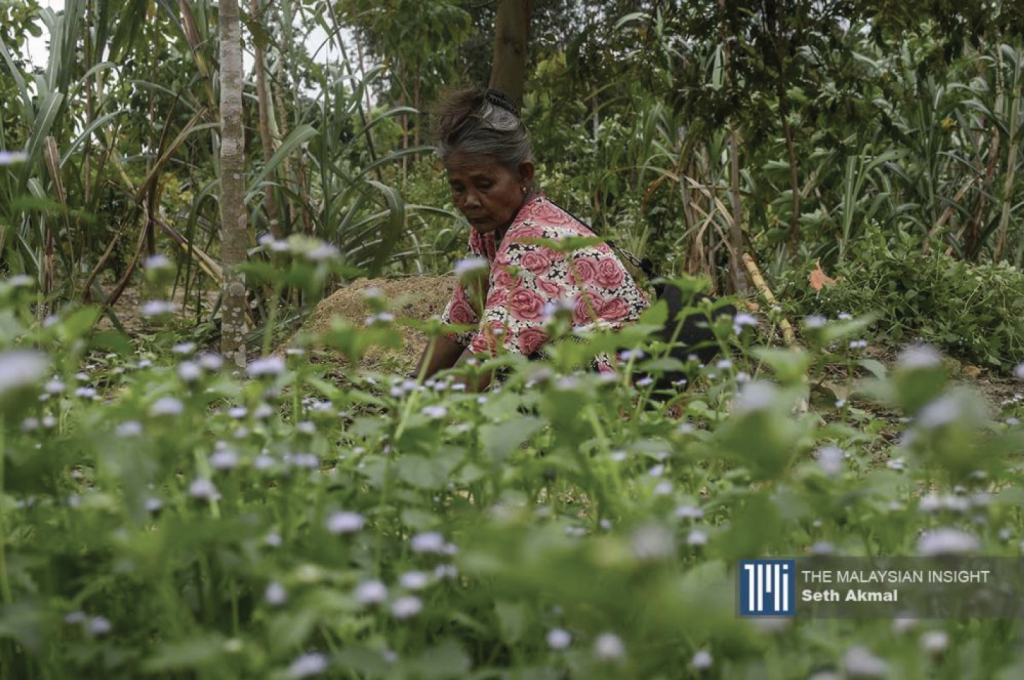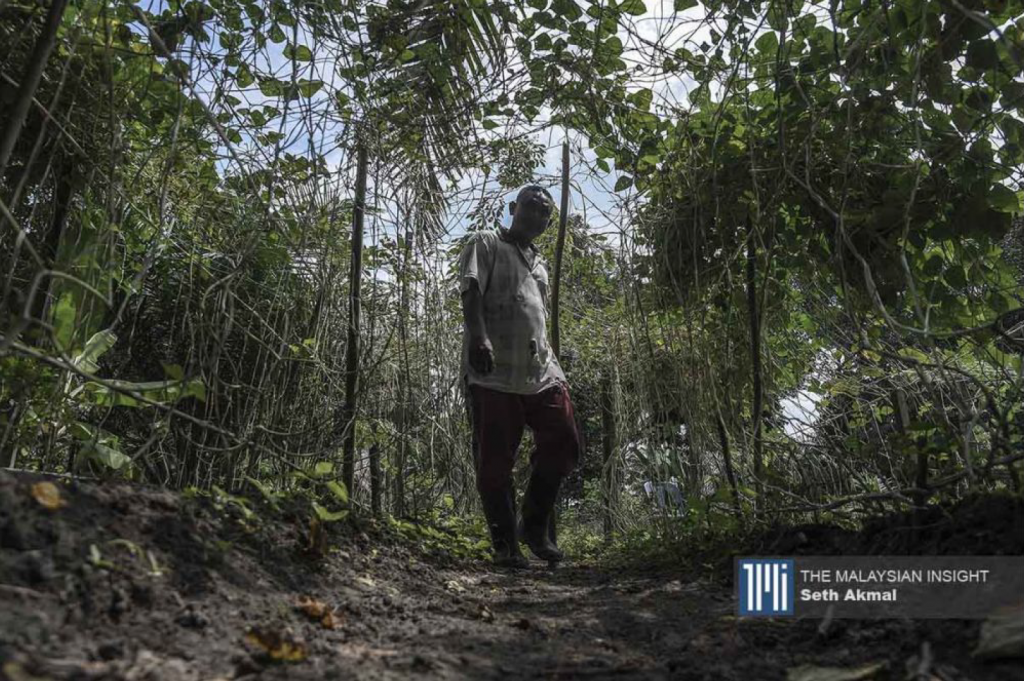
THE Covid-19 pandemic and movement restrictions have brought a fortunate turn for some Orang Asli in Muadzam Shah, Pahang, who began growing their own food and are now enjoying the benefits of extra income and improved diets.
Tapioca and rice had been the daily staple in the early days of the movement-control order (MCO), which began on March 18, and supplies soon ran out.
The situation forced Nodin Kereseng, who lives in Kg Cerampak within an oil palm plantation in Muadzam Shah, to start his own vegetable plot, which was eventually enough to provide for his family and other villagers.
The 36-year old had worked in Johor on a durian plantation for four years until psoriasis, a skin disease, stopped him from working completely just before the MCO.
He recalled the day in March when he learnt about the coronavirus when he was out in a nearby town.
“I was stopped at a roadblock and told to go home.
“I quickly came home and told the rest of the villagers about the virus and told them to stay home,” he told The Malaysian Insight on a recent visit there with civil society group, Global Peace Foundation.
With no help and very little money, food started to become scarce for Kg. Cerampak villagers. Nordin then decided to try planting vegetables.
With no help and very little money, food started to become scarce for Kg Cerampak villagers. Nordin then decided to try planting vegetables.
“At first, I had no fertiliser, but I tried it anyway and it was a success.”
He began by planting several types of vegetables including long beans and chili.
Nordin did not think his vegetable plot would evolve into something larger. His idea at the time was just to have enough food for his family while waiting for aid from the Orang Asli Development Department (Jakoa) and civil society groups.
“I also told my neighbours they could come and take whatever they want from my vegetable plot without any charge,” he said.
Gradually, Nordin realised that if he could plant more, he could sell his produce to other people on the oil palm plantation.
“So once my family and the villagers have taken what they need, I’ll take the leftovers and sell them in stacks of five ringgit. Everything is sold in less than 15 minutes,” Nordin said.
He loads his vegetables on his motorbike and rides to other villages within the plantation.
Nordin said he has come to realise how eating tapioca with rice on a daily basis is not ideal for health. Orang Asli were originally forest people, foraging for food and hunting for meat, but Malaysia’s rapid development over the last few decades have seen more and more of them displaced, losing their traditional way of life and food sources, and their forest homes turned into plantations.
“Most of the time, we depend on tapioca and rice, we wish we could have more, but what to do? We only eat what we can find,” he said.
Nordin hopes the government can look into helping him grow his vegetable farm and turn it into a business, as it would mean a sustainable income for him.
Through the vegetable farm, he said he can help provide for his family’s food security as well as the villagers’ wellbeing.

In Kg Bukit Biru, another village in Muadzam Shah, Orang Asli couple Jamidah and Yati have also started a home garden because of the MCO.
Their main source of income had been chopping and weaving the leaves of the Bertam tree, a type of sago tree, into rattan products.
However, buyers stopped coming to collect their products because of the MCO, leaving them with no income.
The couple said Kg Bukit Biru residents immediately blockaded the entrance to the village upon learning about the virus.
“We dared not go out, even if we wanted to buy things. We would only ask one person in the village to go out and buy things,” Makcik Yati said.
It was then that she and her husband started planting turmeric, long beans, lemongrass, chilli, peanuts, and green beans as a way to improve their family’s food security.
“We had our eight children living in our house during the MCO this way, we could save some money and ensure we have food supply.
“Most of the time we would have tapioca with rice, now we can have vegetables.”
The villagers of Bukit Biru would normally be able to get fish from a nearby river, but were not able to during the MCO because there were police patrolling the area.
Besides their home-grown vegetables, the couple also depended on food aid, whenever it was delivered.
On their dependence on tapioca, the Orang Asli met said it was a staple because it was one of the easiest foods to find in the forest.
They eat it boiled, with rice, or dipped in flour and fried, before eating it with sugar.
Global Peace Foundation CEO Dr Teh Su Thye, who took The Malaysian Insight to the Orang Asli villages, said that a daily diet of tapioca and rice only can result in malnutrition.
“You would see OA women who are plus-sized, but this does not mean that they are well-fed, most of the time, it’s because the things they eat are high in carbs,” said Teh, whose organisation has been working with the Orang Asli for six years.
According to a 2019 document, Malnutrition and Poverty among the Orang Asli (Indigenous) Children of Malaysia (https://www.ohchr.org/Documents/Issues/Poverty/VisitsContributions/Malaysia/IndigenousChildren.pdf) by Dr Amar Singh, childhood malnutrition among Orang Asli children is alarming, with 60-70% of them malnourished by 5-7 years of age.
“The primary reason for poor health is the high prevalence of malnutrition caused by external social factors affecting the Orang Asli people including resettlement schemes, logging and river silt pollution; all resulting in a loss of protein sources (fish and wild boar),” the document said.
The poverty rate among Orang Asli is also high, at 80%, with many considered hardcore poor.
Several Orang Asli households visited during the trip ate tapioca and rice three to four times daily, depending on supply. Some households only ate meals twice a day.
One couple in their mid-40s said they relied heavily on tapioca. The husband, Nenek Aloy, said he would only eat once or twice a day, and only drink tea at night as a meal replacement.
If his grandchildren visit, they would be fed deep fried tapioca dipped in flour and eaten with sugar.
“I’m interested in farming my own food, but unfortunately the seeds and fertilisers are expensive and I don’t have the money to buy it,” he said, adding that he has only so far managed to plant long beans and cili padi.
More Orang Asli are keen to run their own farms in order to live more sustainably and have more nutritious meals.
The main things that hinder them from growing a farm of their own is the lack of water supply, the high cost of farming and fear of losing the farm due to land encroachment.
Nordin, Jamidah and Yati all agreed: “With my own vegetable farm, I can secure my family’s future, I can pay for my kids’ education, I can help my fellow villagers grow healthier too.” – August 21, 2020.
Written by Aminah Farid
Published on 21 Aug 2020
Article reposted with permission from: https://www.themalaysianinsight.com/s/267962
[/vc_column_text][/vc_column][/vc_row]






